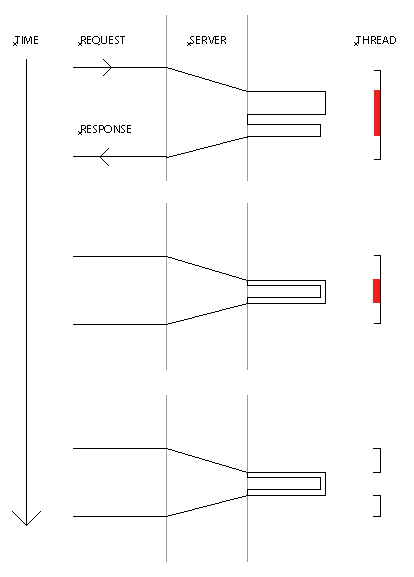-
Notifications
You must be signed in to change notification settings - Fork 9
Fuse
This requires latest rupy.
This is how the current client/server tools work in a co-operative solution:
time <---------------- goes forth & back ------------------>
wait .... ..... .... .... ..... ....
loss ..... ..... (CPU)
+--------+ +---------+ +---------+ +---------+
| | -> | | ---+----> | | | |
| brow | | sync1 | | | sync2 | .. | serv2 |
| | <- | | <----+--- | | | |
+--------+ +---------+ | | +---------+ +---------+
| |
+---------+
| |
| serv1 |
| |
+---------+
-
brow=syncreq(browser) -
serv=syncres(database) -
sync=syncreq&res(old web-server)
The idea is to only wait in the network (no related IO-wait) and to wait for multiple things at the same time:
time <--------------- goes forth & back --------------->
wait .... .. .. ....
+--------+ +---------+ +---------+ +---------+
| | -> | | -+--> | | | |
| brow | | asyn1 | | | asyn2 | .. | serv2 |
| | <- | | <--+- | | | |
+--------+ +---------+ | | +---------+ +---------+
| |
| +---+
+---+ |
| |
+---------+
| |
| serv1 |
| |
+---------+
-
brow=syncreq(browser) -
serv=syncres(database) -
asyn=asynreq&res(FUSE)
For this we introduce a new concept; FUSE. With FUSE all threads asyn end-to-end or socket-to-socket if you will, they never wait for anything.
Another way to describe this is time and IO-wait shown in the graph below:
-
syncreq&res(old web-server) -
asynreq(netflix) -
asynreq&res(FUSE)
You can imagine that the compounded savings in terms of time and wait are huge, specially when the system grows in concurrency and depth. As a matter of fact, you can't scale at all without asyn req and with asyn req & res you're far better off.
If you want to use µSOA this is the most performant way to build your services network.
You can even use this as a load balancer.
Another use case for this is our cluster database ROOT.
This example fuses data asyn from multiple servers to your browser ASAP on a raspberry pi with zero thread IO-wait:
// TODO: Improve latch.
public static class Fuse extends Service {
public String path() { return "/fuse"; }
public void filter(final Event event) throws Event, Exception {
if(event.push()) {
Http[] http = (Http[]) event.query().get("http");
Output out = event.output();
int done = 0;
for(int i = 0; i < http.length; i++) {
if(http[i].print(out)) {
done++;
}
}
if(done == http.length) {
out.println("</body></html>");
out.finish();
}
out.flush();
}
else {
event.query().put("time", System.currentTimeMillis());
Http[] http = new Http[2];
String path = "/v1/public/yql" +
"?q=select%20*%20from%20yahoo.finance.xchange%20where%20pair%20in%20(%22USDSEK%22)" +
"&format=json&env=store%3A%2F%2Fdatatables.org%2Falltableswithkeys";
http[0] = new Http("one", "strip.rupy.se", "/?a=martin+kellerman&body", event);
http[1] = new Http("two", "query.yahooapis.com", path, event);
for(int i = 0; i < http.length; i++) {
// The 10 at the end is very important.
// It means the socket will be kept alive
// for 10 seconds since last active.
// This is our Murphy's law solution.
event.daemon().client().send(http[i].host, http[i], 10);
}
event.query().put("http", http);
}
}
public static class Http extends Async.Work {
private String name;
private String host;
private String path;
private String body;
private Event event;
public Http(String name, String host, String path, Event event) {
this.name = name;
this.host = host;
this.path = path;
this.event = event;
}
public boolean print(Output out) throws Exception {
if(event.query().get(name) instanceof Http) {
long time = System.currentTimeMillis() - event.big("time");
System.out.println(" " + name + " " + time + " ms.");
out.println(body);
event.query().put(name, "done");
return true;
}
else if(event.query().get(name) instanceof String) {
return ((String) event.query().get(name)).equals("done");
}
return false;
}
public void send(Async.Call call) throws Exception {
call.get(path, "Host: " + host + "\r\n");
}
public void read(String body) throws Exception {
this.body = body;
event.query().put(name, this);
System.out.println(" " + name + " success " + event.reply().wakeup());
// Normally it's better to wakeup the response after all client requests are finished,
// but we wan't to show you the parts as they complete on-the-fly!
}
public void fail(String host, Exception e) throws Exception {
if(e instanceof Async.Timeout) {
System.out.println(" " + e);
event.daemon().client().send(host, this, 10);
}
else {
e.printStackTrace();
event.query().put("response", e.toString());
System.out.println(" " + name + " failure " + event.reply().wakeup());
}
}
};
}




